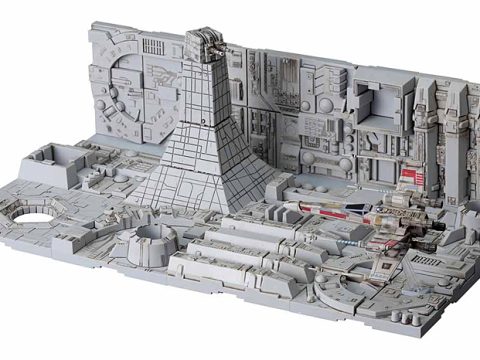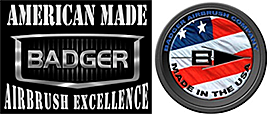
So, by now (hopefully) you have chosen the airbrush that fits with your needs, and now you are ready to start laying down paint. So, lets break out those paints and start to spray!!! OK, maybe we got ahead of ourselves here! There are still a few more things that we need to get in order to start, but I promise you that it won’t be long now till you are painting up a storm.
Air source – First things first, you need an air source to get yourself up and spraying. The good news is that there are lots of options, and they start from relatively inexpensive, all the way to…. “You paid how much for that?”
Canned air – this is one of the easiest ways to get into airbrushing. Most airbrushes can be connected to a can of compressed air with a simple adapter and hooked into a standard hose. The adapter has a rudimentary pressure valve, that while not extremely precise, can regulate pressure.
Pros: Cons:
Inexpensive (also see cons) Expensive over time (compared to compressor)
Easy setup Pressure fluctuations (as the can chills)
Space saving Not able to dial in precise PSI
It will eventually run out (need spares)
Overall: I don’t recommend canned air for the frequent modeller. The lack of regulation, the inconsistent spraying, and the long-term cost vs a compressor makes it not viable for the long-term modeller. If you are spraying a single project, it may be the way to go, but over all, stay away from it.

Compressed Gas (co2, nitrogen) – I didn’t add this to canned air because I think that this is a totally different type of setup. Co2 or nitrogen are becoming more popular in modelling and cosplay circles. The gas is stable, low moisture, and maintains pressure well. A regulator will need to be added to the setup, and maybe a water trap, but those are one-time costs.
Pros: Cons:
Inexpensive fill per tank (cents per litre) Expensive start-up (tanks and regulator)
Extremely consistent pressure Must be refilled eventually
Little to no moisture Bulky
Long lasting (dep. on cylinder size) Dangerous if not handled correctly
Sound (near silent)
Overall: I wouldn’t recommend compressed air for the casual modeller or someone who has no equipment. The high start-up costs, the size and danger of handling, as well as the refilling part make them a bit too much work for me. However, if you have the tanks and are comfortable with the process, the total lack of noise and consistent pressure may be of particular appeal to you!

Compressor– this is the most commonly used source of air. They come in a variety of forms, from tankless on-demand type of hobby compressors, to very large (and noisy) tanked construction grade models. We want to fall somewhere in between with a tanked (3L) hobby model. These are “relatively” inexpensive (brand names like Iwata can cost a premium), compact, quiet, and low maintenance. They will usually come with a decent regulator and water trap and are easy to setup out of the box. This does not mean that you shouldn’t buy a tankless model of compressor, but I have found that most modellers move into the tanked model eventually, so rather than buy twice, save up your pennies and buy once. I bought a generic one from Amazon 2-3 years ago and use it constantly. No issues so far and it is solid as a rock. Compressors do have a tendency to build moisture in the tanks, so a water trap of some sort is needed, and if you use an oil lubricated one, oil can get in the line as well.
Pros: Cons:
Quiet Moisture/oil (water trap)
Low maintenance Vibrations (if on desk)
Inexpensive
Overall: This is my recommendation for most modelers. They are easy to use, easy to maintain, quiet and will last for years. I do prefer a tanked model, it makes sure there are no variations in pressure from the actual compressor, and it means that the compressor will not have to kick in as often to maintain that pressure.

Accessories – So there are a few more things that you will need in order to start airbrushing. I am going to suggest that some of these “must have’s” for obvious reasons and others are “nice to have”.
Must Have’s:
- Air hose – ok, no brainer here, you need a line to connect to your tank, but there are lots of types. I recommend a braided air hose, that is one that has a protective sheath over the line for protection, and at least 10 feet long. This will ensure that it is durable and will withstand the occasional chair being rolled over it, and long enough that you will not run out of line.
- Spray Out Pot: You will need to change colors and clean your airbrush. A spray out pot allows you to direct any unused paint or cleaners into a sealed and filtered chamber and allow you to quickly flush your airbrush. The alternative is to flush it over paper towel, which can get messy.
- Spray booth / respirator: Some will argue that this is not a “must”, but I will argue it is…. unless you don’t care about overspray and breathing in atomized paint. You don’t need anything more than a carboard box to catch overspray, but if you couple that with a cheap fan and filter, and a respirator, you are fully covered. Remember, you only have one set of lungs!
- Airbrush cleaner: I can hear it now, you can use water to clean an airbrush. Technically that is true, but how much time and effort do you want to spend using only water? You don’t need to buy expensive brand name cleaners. For acrylic paints, a 4L (1 gallon for my imperial friends) container of windshield wiper fluid will do the trick, and I have used it for years. If you want a bit more bite, mix it 50/50 with isopropyl alcohol. That will clean out most acrylic paints, and it lasts forever. Since I started airbrushing again I have gone through maybe 4L in total of cleaner. A little goes a long way. Now, if you are using lacquer based paints, you will need a solvent based cleaner, and this is once again why you need a respirator!!!
- Turn-table: Again, a questionable “must have”. Sure you can throw your model on a box and rotate that. But its not smooth and for the sake of a $2 cake turntable from the Dollar Store, save yourself some aggravation and grab one. I have 4 of them that I have collected over the years. They are covered with paint, but they still do the job flawlessly. Remember, you want to struggle as little as possible and focus on painting!
Nice To Have:
- Quick Disconnects: There are essentially male to female couplers that allow you to quickly attach and detach your airbrush from your line. Are they needed? But if you switch between your general brush and detail brush frequently, it is so convenient. Some even come with pressure adjustment built in, giving you another level of control on the fly and at your finger tips.
- Hose Water Trap: If you have a water trap at the end of your tank, this is not exactly needed. For a few bucks – mine was $5.00 shipped – you are ensuring no water gets into your air supply, and I personally like the way it makes my airbrush feel in my hand, almost like a pistol grip.
So, there you have it. We now have what we need to start spraying some paint. Again, making informed decisions here will save you some headaches (and wallet ache) in the future. Don’t always go for the cheapest option. The ole idiom “buy cheap, buy twice” springs to mind. Remember, this is an investment – focus on the “must have’s” and get the best you can. Later, when money permits, you can get the “nice to have’s”.













